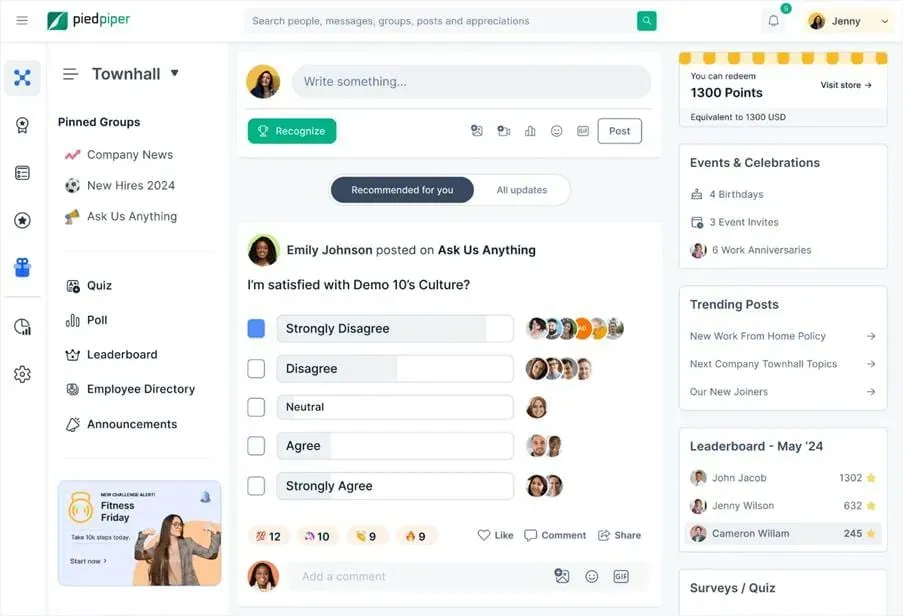On this page
Peter in sales closes more deals every month than his peers. What do you think can be the reason? Is it intrinsic or extrinsic motivation, or is there another reason behind this?
At first glance, his supervisor might credit this success to the company’s incentive programs, a classic case of extrinsic motivation at work. However, the real story behind Peter’s achievements reveals the deeper layers of intrinsic motivation.
Understanding intrinsic vs extrinsic motivation is crucial because what drives an employee’s performance is often more complex than it appears. When considering intrinsic vs extrinsic influences, Peter’s motivation stems not from tangible rewards but from a personal triumph—overcoming a childhood stammer and turning it into a powerful advantage in his career.
Peter’s story shows why understanding intrinsic vs extrinsic factors is essential and this blog dwell deeper into the notion ‘intrinsic motivation vs extrinsic motivation”.
What wakes us up in the morning: Intrinsic motivation or extrinsic motivation?
In short, why do we do what we do? The two principal characters of this hotly debated drama have been INTRINSIC (one that’s born inside us) and EXTRINSIC (added from the world that is ‘external’ to our being) motivation.
Psychologists, philosophers, educationists, parents, and students continue to throw theory and hypothesis at each other, but truth be told, the ways of the mind remain mostly mysterious.
At the same time, research has documented plenty, too. Plenty, that is, to provide Peter’s supervisor with some well-deserved relief (the man had, after all, only done what anyone in his position would – try to ensure that business outcomes maximize and performance appreciated with rewards). So here is what we need to know about the two types of motivation.
1. Extrinsic motivation
A school of thought believes the human psyche is driven by a binary template, with Rewards and Punishment featuring on either side of the coin. The stimulus (i.e., ‘reason to act’) here is tangible mainly, things visible to us and part of the external universe where we live.
In the case of the iceberg model -where the top half deals in manifested and measurable behavior and the bottom half dwell on deeper drivers and triggers that cause those behaviors - extrinsic motivation roughly maps to the visible portion of the ice.
Suppose you consider Maslow’s Theory of Motivation. In that case, you will find extrinsic action roughly corresponding to the bottom half of the pyramid, which is where most of the existential and worldly things - glory, pleasure, and security – live.
In the workplace context, extrinsic motivation makes us do things like reaching targets before the deadline so that we don’t miss out on our allotted incentive. Also, learning a new course to get promoted faster and follow organizational codes and policies so that we are not penalized for non-compliance.
Common forms of extrinsic motivation in the workplace
Extrinsic motivation can take various forms in the workplace, often tailored to meet specific goals or company values. Some of the most common and effective forms include:
1. Financial incentives
One of the most direct ways to motivate employees is through financial rewards. This could be in the form of salary raises, performance-based bonuses, or commissions. These incentives can be especially useful when employees are working toward specific, measurable goals. Financial rewards serve as a clear motivator since they provide immediate, tangible benefits.
2. Recognition and rewards
Recognition goes beyond financial rewards, offering acknowledgment of an employee's hard work. Whether it's a simple “thank you” from a manager, public recognition in meetings, or formal awards like "Employee of the Month," these acknowledgments can have a big impact on morale. When people feel valued, they’re often motivated to maintain or exceed their current performance levels.
3. Promotions and career advancement
Offering opportunities for career advancement is a strong form of extrinsic motivation. Employees who know they can climb the corporate ladder are more likely to stay engaged and put in extra effort. The promise of a promotion, additional responsibility, or even a new title can drive long-term motivation, making employees work harder to prove they’re ready for the next level.
4. Job security and benefits
Non-monetary incentives such as job security and comprehensive benefits packages are key motivators. Knowing that their job is stable or that they have access to health insurance, paid time off, or retirement plans can encourage employees to perform better. These benefits provide a safety net that makes employees feel appreciated and secure, which in turn drives commitment.
Each of these forms of extrinsic motivation can shape an employee’s approach to their work, ensuring that both the individual and the company benefit.
2. Intrinsic motivation
In other words, if you are reaching targets faster because you love what you do (i.e., you live for the goosebumps that every successful pitch brings and are not consciously chasing KPI check-boxes), learning a course or skill because you are dying to master that cool new tech and following your company’s rules and regulations because you cherish the culture (and therefore feel ‘naturally protective’ about it), you are intrinsically motivated.
Intrinsic motivation comes from your inner self or something which you do as a reward for yourself. The activity is, in that sense, its justification and its reward. Intrinsic motivation roughly maps to the bottom, or invisible, half of the iceberg.
From the perspective of Maslow’s Theory, intrinsic behavior roughly corresponds to the top half of the Pyramid, where our ‘higher needs - such as self-esteem, sense of achievement, a feeling of ‘belonging’ or a desire for self-development and improvement - reside.
Common forms of intrinsic motivation in the workplace
1. Meaningful work and purpose
Employees find intrinsic motivation when their work is meaningful and aligned with a larger purpose or mission. When they can see the impact of their contributions on the organization, society, or the world, it fosters a sense of fulfilment and commitment.
Patagonia: Patagonia is a well-known outdoor clothing company that has a strong commitment to environmental sustainability. Employees at Patagonia are motivated by the company's mission to "save our home planet." They engage in projects and initiatives that promote sustainability, which gives their work a profound sense of purpose.
2. Personal growth and development
Providing opportunities for personal and professional development is a powerful intrinsic reward. When employees have the chance to learn, grow, and develop their skills, they feel more engaged and satisfied in their roles.
General Electric (GE): GE's leadership development programs are renowned for nurturing talent within the organization. They invest in leadership training and mentorship to help employees achieve personal and professional growth.
3. Autonomy and ownership
Granting employees autonomy and ownership over their work is another effective intrinsic reward. When individuals are free to make decisions, be creative, and take responsibility for their tasks, they are more motivated and engaged.
3M: 3M is known for its "15% Time" policy, which allows employees to spend up to 15% of their work hours on projects of their choice. This autonomy has led to innovations like Post-it Notes and Scotchgard, which were developed by employees pursuing their own ideas.
The difference between intrinsic and extrinsic motivation
The difference between intrinsic and extrinsic motivation is that extrinsic motivation is all about status, money, fame, power. On the other hand, intrinsic motivation is concerned with our sense of individuality, purpose in life, and things that bring us joy and fulfillment.
Intrinsic motivation usually manifests in more ‘voluntary’ and ‘spontaneous’ forms of activities, such as learning to sing or helping out a sick coworker. Loosely put, if extrinsic motivation makes us ‘look good’, intrinsic motivation makes us ‘feel good’.
It is said that this kind of bucketing can be too simplistic or uni-dimensional, and extrinsic and intrinsic forms of impetus can at times be hard to tell apart. It is perhaps best to think of them as a combination that is continuously moving along a continuum, and it is only at the extreme ends of this spectrum that extrinsic and intrinsic forms of motivation can be said to be truly mutually exclusive.
For example, something that makes us ‘look good’ may also be motivated from within- in the sense that someone may spend hours in front of the mirror dressing up for a party not to impress others but simply because s/he is a perfectionist. Similarly, something that makes us ‘feel good’ – such as providing for the family or excelling at work - can at another level be extrinsically motivated.
Extrinsic vs. intrinsic motivation: Which is better?
It is easy to be idealistic when comparing the two forms of motivation and putting intrinsics on a higher pedestal. But a ‘self-fulfilling’ society that runs on auto-pilot where each of us are perfectly self-motivated is a perfect picture, an ideal world. In a practical sense, both forms of motivation are required for the community to function properly. And while theories like that of Carol Dweck’s can tend to equate intrinsic motivation with a Growth Mindset and extrinsic motivation with a Fixed Mindset, there is much to be said for both.
Extrinsic motivation – whether by the pull of incentive or the push of punishment -provides the tug and trigger we need to stick to deadlines, ensures order and consistency (by complying with set benchmarks), and ensures that customers are smiling at the end of the day. It is particularly useful in keeping productivity levels humming even when the task by itself is unappetizing, which, for better or worse, is often the case in ‘real’ life.
Finally, an initial ‘extrinsic push’, says an incentive, is one of the most effective – sometimes the only – way to make people overcome inertia, step outside their comfort zones, and explore new skills or try new things. On the flip side, an extrinsically stimulated team may not have a sense of ownership to the task (doing only as much as they have to), give up easily if agreed-to conditions change, and lack the urge to innovate.
Intrinsic motivation – on its part – can help a business build a competitive edge that is near impossible to copy because the standards met here are ‘within’. When employees are fired up with a greater sense of purpose (that goes beyond defined KPIs), in other words, when they ‘truly want something, they are far more likely to do the job satisfactorily. What’s more, they may not stop even after meeting the official quality benchmark, chipping and chiseling away at their masterpiece till it’s ‘just perfect’.
Conversely, intrinsically motivated teams will be quick to re-do when a goal is not met, often without being asked. Intrinsically driven employees are usually more committed to the task, more resilient in the face of hurdles, and more innovative when cracking novel solutions.
Everything has a downside; intrinsically motivated teams can be picky about choosing their tasks, indifferent to ‘horizontal growth’ (that is, jumping careers or exploring new skills that don’t excite them), and quick to lose their ‘mojo’ if conditions change.
The question founders, talent leaders, and HR managers need to ask is not the difference between intrinsic and extrinsic motivation or which kind of motivation is better, extrinsic or intrinsic. The big question that needs addressing is which one your organization needs more?
The answer is BOTH, of course, but you still need to figure out the right ratio between the two so that you can design your performance processes and workflow models around it.
This ratio depends on a few factors, like the nature of the activity or work (the product or service) your organization is involved in. The extrinsic-intrinsic rate is also influenced by the goal-rewards model you have designed for your team. And most importantly, it must be in sync with the personality and psyche of your workers.
Here’s a quick comparison to understand the strengths, weaknesses, and roles of intrinsic and extrinsic motivation:
|
Aspect |
Intrinsic
Motivation |
Extrinsic
Motivation |
|
Definition |
Driven by internal satisfaction, passion, or purpose. |
Driven by external rewards such as money, recognition, or
benefits. |
|
Key Focus |
Personal growth, fulfillment, meaning, creativity. |
Tangible rewards, deadlines, performance metrics. |
|
Examples |
Loving the work itself, personal mastery, purpose alignment. |
Bonuses, promotions, awards, public recognition. |
|
Strengths |
Encourages resilience, innovation, and deep commitment. |
Boosts immediate productivity, ensures compliance,
triggers performance. |
|
Drawbacks |
May lead to selective effort, loss of motivation if
passion fades. |
Can create dependency, reduce intrinsic interest if
overused. |
|
Best Use Cases |
Long-term projects, innovation-driven roles, leadership
building. |
Meeting short-term goals, sales targets, regulatory
compliance. |
|
Impact on Company Culture |
Builds strong emotional connection and ownership. |
Reinforces measurable achievement and accountability. |
|
Risks if Overemphasized |
Risk of burnout or disengagement if personal goals are
unmet. |
Risk of "doing the bare minimum" or losing
passion for the work. |
Designing around motivation levers: how organizations should respond?
An organization is all about its people, which makes this the most important – and trickiest -part of your business. Get this right, and you will have hit upon the proverbial Golden Goose: A ‘people system’ that runs on a happy loop and keeps delivering with consistency and quality.
Botch this up, and you enter a vicious cycle or sub-par performance, iterations, and blame games which only go from bad to worse and take the business nowhere.
The managers and supervisors need to remember while re/designing their workflow around a context of hunger and motive is that everyone’s impulse buttons and motivational triggers are different.
Some of us are extrinsically driven by habit, while others instinctively look inward for inspiration. Find out what moves your team and align your motivation triggers accordingly.
The other thing to remember is that things are not always black and white and that one carrot doesn’t spur every stick.
Elements to add to your motivation matrix
To get the best out of your people (and this includes digital offices and remote teams), align them accurately with the criss-cross of stimulus flowing across the workplace.
As we have seen, it isn’t always easy to separate extrinsic motivation from intrinsic since it is the ‘user’ who ultimately interprets and decides. It means you don’t have to create mutually exclusive spaces (like, say, smoking and non-smoking sections) for your workers who subscribe to the two categories.
The idea is to empathize, enable and empower–and let things fall in place. In other words, create the conditions and customize the environments so that the right motivation–be it extrinsic or intrinsic–is kindled in every situation.
1. Autonomy
People who are motivated extrinsically or those who are more internally driven, nobody likes to do anything at gunpoint. Even subtle hints of control can break the morale down.
Barring the ‘unsaid’ and clear rules of the game (such as core company policies, for instance), it’s good to step back and give your workers the space to do things their way.
2. Recognition
This is not just an external stimulus (a standard error). Remember, grey areas exist. An intrinsically motivated person can be equally motivated by the lure of a luxury vacation or fancy car if it aligns with their value systems, passions, and journey.
At the other extreme, recognition doesn’t always need to be ‘things’ – it can be a warm pat on the back or a more ‘public’ hat-tip on the company’s intranet page. The point is to be quick, genuine, and appropriate in appreciating good work.
3. Feedback
Feedback is both an enabler and an incentive. At one end, it helps fine-tune performance by supplying vital inputs and direction. At the other end, a ‘good word or two’ (positive feedback) can add to the satisfaction of a job and involvement in the process–while boosting productivity simultaneously. Whether one is motivated–extrinsically or intrinsically–feedback can act as a powerful trigger.
4. Sense of competence
Make sure success is meaningful and leads to the personal growth of your employees. Design their curve so that every target and every massive milestone instills a sense of achievement. While this is essentially an intrinsic stimulant, externally stimulated people undoubtedly won’t complain about the ego high this brings (which can, as a happy bonus, push them to raise their game).
5. Relatedness
It refers to a sense of attachment and belonging to the workplace. An intrinsic motivator, in essence, relatedness, starts with an inspiring and supportive culture your people can quickly identify with and are willing to spend the extra sweat for. A genuinely great culture can have a strong influence even on extrinsically motivated people, balancing the equation with a healthy mix of outside and inside catalysts.
6. Role-talent fitment
This may be basic and obvious, but still worth mentioning. People caught in the wrong jobs'll be demotivated. In case recruitment starts on the wrong foot, you can still turn the boat around by keeping opportunities of horizontal growth open - so that a ‘misfit’ can find a more suitable role, one that lets them shine by aligning better with their motivational triggers.
7. Moderation
This one’s about how you dish it out. It is important not to ‘overdo’ it as people leaders and department managers. Research shows that raising the stakes or incentives in an activity that someone already finds compelling (intrinsically engaging) will deliver incremental returns but only up to a point, after which the tactic can backfire.
For example, a coder passionate about programming may shine brighter when perks are linked to his performance. After a point, however, it is the perks that may start defining the behavior, killing the natural spark, and reducing the programmer to a bot who delivers just enough to tick his boxes, pocket his rewards and go home.
Humans can look at the same event through their unique lens and may internalize or align the same situation with their distinct values – and no two prisms/lens or ethos/values are quite the same.
How Empuls drives employee motivation through recognition and rewards

Empuls offers a complete platform that enhances extrinsic motivation by turning recognition and rewards into a seamless and impactful experience. Here's how Empuls helps:
1. Fostering a culture of appreciation
Empuls goes beyond traditional recognition programs by using AI-assisted tools to celebrate every employee's win, whether big or small. The timely and inclusive nature of recognition leads to measurable improvements in employee engagement and retention, keeping employees motivated through acknowledgment of their hard work.
2. Prioritizing employee well-being
Empuls offers perks and benefits that cater to the well-being of all employees, regardless of their demographic. These comprehensive programs touch employees’ lives beyond just their work responsibilities, ensuring that their overall well-being is prioritized, which boosts their motivation to stay engaged and perform at their best.
3. Multiple award types
Empuls provides a variety of award options to ensure that employees are recognized in the moment, whether through value badges, spot awards, or peer recognition.
For more formal recognition, Empuls includes approval-based awards where nominations are reviewed by a panel, as well as performance-based awards tied to specific goals. These tailored awards keep employees motivated by offering rewards that match their achievements.
4. Automating rewards and budgets
Empuls simplifies the reward process with automated workflows that handle the distribution of reward budgets, making it easier for managers to ensure fair and timely rewards.
Employees can instantly redeem rewards through the built-in rewards store, creating an effortless and satisfying experience. The platform also offers full visibility into budget utilization so companies can easily track and manage reward spending.
5. Celebrating milestones and service awards
Empuls transforms milestones like years of service and life events into memorable celebrations for the entire workforce. With its modern milestone and service awards program, employees feel valued and connected to the company, further boosting extrinsic motivation.
Personalized and automated awards, such as branded certificates and letters of appreciation, create a meaningful recognition experience for every employee.
6. Tax-compliant rewards
Empuls ensures that rewards are tax-compliant, allowing companies to focus on meaningful recognition without the hassle of budget reconciliation. The platform generates detailed reports, offering transparency and control over every reward expenditure, making it easy to maintain compliance while boosting employee motivation.
Empuls delivers a holistic approach to extrinsic motivation by offering timely recognition, personalized awards, and seamless reward processes. By creating a culture of appreciation and celebration, Empuls ensures that employees feel motivated and engaged every step of the way. Schedule a call with their expert today!
Conclusion
Extrinsic and intrinsic motivation can co-exist. Sometimes, one may even be camouflaged as the other. It happens because humans can look at the same event through their unique lens and may internalize or align the same situation with their distinct values–and no two prisms/lenses or ethos/values are quite the same.
For someone, being the ‘Employee of the Month’ is essential because it comes with a dinner voucher at a fancy restaurant (extrinsic).
For someone else, like, say, Peter in our opening example - it may hold special significance either as a thumbs-up to the self or as a thumbing-of-the-nose to the competition(intrinsic). How deftly you walk the grey areas of the impulse terrain decides how intuitive your ‘stimulus ecosystem’ is.















